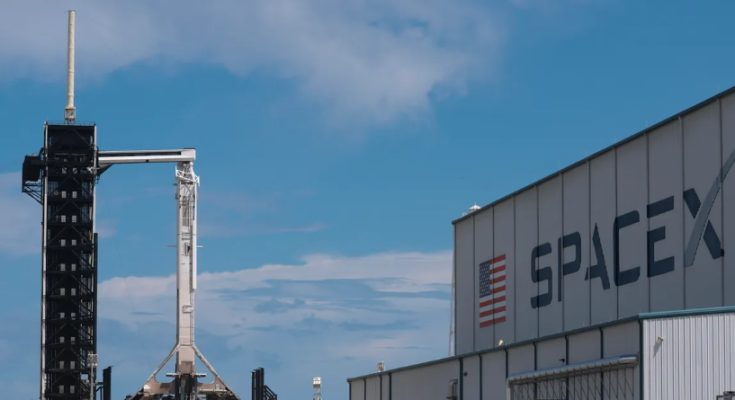SpaceX Launches Polaris Dawn Into Orbit: What to Know About the Mission
Four astronauts are ready to spend five days in orbit on a mission that includes the first attempted spacewalk by private astronauts.

An unprecedented space mission lifted off from NASA’s Kennedy Space Center in Cape Canaveral, Florida, early Tuesday. Dubbed Polaris Dawn, the first-of-its-kind mission used a SpaceX Falcon 9 rocket to launch a Crew Dragon capsule containing four private astronauts for a five-day orbit.
The mission is a follow-up of sorts to a 2021 private mission called Inspiration4. It was also backed by billionaire Jared Isaacman, the founder and chief executive of the data company Shift4. Polaris Dawn has been in the works for several years; at one point, there was talk of sending a crew to boost the life of the Hubble space telescope.
This new mission isn’t that. Instead, the crew will attempt the first spacewalk of private astronauts, using spacesuit technology developed by SpaceX. They will also test laser-based communications with satellite broadband provider Starlink as part of an effort to pave the way for travel to places including Mars. Starlink is a subsidiary of SpaceX, which is owned by Tesla CEO Elon Musk.
The risks aren’t negligible: The crew will attempt to achieve the highest orbit of Earth ever recorded and will pass through heavy radiation and risk potentially significant damage from small space rocks and debris.
What’s the status of the Polaris Dawn mission?
The Falcon 9 rocket blasted off at 5:23 a.m. ET on Tuesday, following two weeks of postponements. SpaceX marked the occasion with a short, to-the-point message on X: “Liftoff of Polaris Dawn!” Shortly afterward, the first-stage booster returned, landing on its target droneship as the spacecraft continued its ascent. Within 15 minutes, the crew was in orbit.
Tuesday’s launch window was the latest in a series of opportunities that had come and gone since late August. “Targeting no earlier than Tuesday, Sept. 10 for Falcon 9’s launch of the Polaris Dawn mission,” SpaceX said in a post on the X social network (formerly Twitter) late Monday. “Weather is currently 40% favorable for liftoff, and conditions at the possible splashdown sites for Dragon’s return to Earth remain a watch item.”
The original launch date in the last week of August was scrubbed to allow for “a closer look at a ground-side helium leak on the Quick Disconnect umbilical,” SpaceX said at the time in an X post. A day later, the Polaris Dawn team stood down again “due to unfavorable weather in Dragon’s splashdown area off the coast of Florida,” the company said. Isaacman had earlier posted on X that the launch team would assess conditions day by day.
“Crew safety is absolutely paramount and this mission carries more risk than usual, as it will be the furthest humans have traveled from Earth since Apollo and the first commercial spacewalk!” Musk posted in late August on X, which he owns. “If any concerns arise, the launch will be postponed until those concerns are addressed.”
How can I watch and follow Polaris Dawn’s mission?
In addition to news coverage, you can find updates on Polaris Dawn on the mission’s website, X, Instagram and Flickr, where photos from the mission will be posted.
Who’ll be on the mission?
The crew comprises four members. They are:
Jared Isaacman, the Shift4 CEO, who’s said to be spending hundreds of million dollars on the mission, on which he’ll serve as mission commander. Isaacman was on the Inspiration4 mission in 2021 as well.
Sarah Gillis, SpaceX’s senior operations engineer, who’s trained NASA astronauts and who’ll serve as mission specialist for Polaris Dawn. Along with Isaacman, she’ll be one of the two crew members who perform the spacewalk.
Scott Poteet, who served as mission director of Inspiration4, is a former fighter jet pilot for the US Air Force. He’ll be doing communications and spacewalk assistance on the mission.
Anna Menon, a lead space operations engineer at SpaceX, will be in charge of the crew’s health during Polaris Dawn.
What do they hope to accomplish on this mission?
In addition to the spacewalk, which Isaacman and Gillis will be the first private astronauts to perform, the mission will also test laser communications with Starlink and perform a series of biology and human endurance tests, according to the Polaris Dawn website.
The spacecraft is expected to travel to an orbit as far as 870 miles above the Earth, just past the altitude record of 853 miles set by the Gemini XI mission in 1966, according to The New York Times. For comparison, the International Space Station orbits at roughly 250 miles.
If successful, Polaris Dawn would be the first of three missions, the next two of which would use SpaceX’s new Starship rocket.
Correction, Aug. 28: An earlier version of this article incorrectly stated the name of Jared Isaacman’s company. He’s CEO of Shift4.
SpaceX Breaks Its Booster Recovery Streak With First-Stage Falcon 9 Rocket Crash
SpaceX lost a first-stage booster during a Starlink satellite launch this week.

SpaceX launched more Starlink satellites via a Falcon 9 rocket Wednesday morning, but lost a first-stage booster in the process when it toppled over into the Atlantic Ocean and caught fire. While the rest of the rocket made it to space and deployed 21 satellites, a planned second launch in California was scrapped so that the SpaceX team could study the booster mishap.
Falcon 9 boosters are meant to be recoverable. With the incident Wednesday morning, SpaceX broke its streak of 267 successful booster landings since 2021.
It comes as weather has continued to delay the launch of the private Polaris Dawn space mission past Aug. 30. So far, SpaceX has not said whether the failure of the first-stage booster will further delay or affect the Polaris Dawn mission, which also is using a Falcon rocket.
Polaris Dawn, which will send four private astronauts into orbit for a planned five-day mission, will be commanded by Shift4 Payments entrepreneur Jared Isaacman, who previously flew into space on the 2001 Inspiration4 private mission. The new mission was set to launch Monday, Aug. 26, but was pushed back on consecutive days due to unfavorable weather conditions and to get “a closer look at a ground-side helium leak on the Quick Disconnect umbilical,” the company said on the X social media network earlier in the week.
In addition to news coverage, you can find updates on Polaris Dawn on the mission’s website, X, Instagram and Flickr, where photos from the mission will be posted.
Starliner Heads Home Without Astronauts. How They’ll Be Rescued
For 13 weeks, Suni Williams and Butch Wilmore have been on the International Space Station. They were supposed to be there for eight days.

It sounds like the pitch for a creepy science-fiction or horror movie: Two astronauts are stranded on a space station, and their spacecraft — with no crew — leaves them there and returns to Earth.
That’s the scenario that unfolded late Friday when Boeing’s Starliner capsule left astronauts Sunita “Suni” Williams and Barry “Butch” Wilmore on the International Space Station and successfully landed at White Sands Space Harbor in New Mexico.
But for the two seasoned astronauts stuck on the ISS, the situation isn’t nearly as Hollywood-scary as it might sound. Let’s break it down.
Who are the astronauts?
Wilmore, 61, and Williams, 58, are veteran astronauts, both naval officers and former test pilots. Williams has been a NASA astronaut since 1998, and Wilmore since 2000. Both have plenty of experience in space.
Williams is the former record holder for most spacewalks by a woman (seven) and most spacewalk time for a woman (50 hours, 40 minutes), and in 2007, she ran the first marathon by any person in space.
In 2009, Wilmore piloted the Space Shuttle Atlantis on its mission to the ISS, and in 2014, he was part of the ISS crew that used a 3D printer to manufacture a tool — a ratchet wrench — in space, the first time humans manufactured something off-world.
What is their mission in space?
Wilmore, as commander, and Williams, as pilot, traveled to the ISS on a 15-foot-wide, Boeing-made capsule called Starliner. They launched on June 5 and docked with the ISS on June 6. NASA hopes Starliner will give the organization a new way to get crews to and from the ISS, and the fact that it’s Boeing-made is another sign that NASA is starting to lean on the private sector for its human spaceflight options, The New York Times reported.
Wilmore and Williams’ ISS mission was supposed to last a mere eight days, during which they’d test out aspects of Starliner and see how it operates with a human crew in space. But due to complications with Starliner, the two astronauts are still up there and won’t be back before 2025. They’ve kept busy — working with the ISS Expedition 71 crew to perform research and maintenance activities, NASA said.
How did they get stuck in space?
The Starliner was delayed in May due to a problem with a valve in the rocket. Then engineers had to fix a helium leak. That’s all bad news for Boeing, which is competing with SpaceX, which has been transporting astronauts to the ISS since 2020, making over 20 successful trips to the space station.
Starliner finally launched, atop an Atlas V rocket, on June 6, but some problems came along with it. NASA announced that three helium leaks were identified, one of which was known before flight, and two new ones. In addition to the leaks, the crew had to troubleshoot failed control thrusters, though the craft was able to successfully dock with the ISS.
SpaceX has had failures too. A Falcon 9 rocket exploded on the launchpad in 2016. In July, a Falcon 9 rocket experienced a liquid oxygen leak and deployed its satellites in the wrong orbit, The New York Times reported. And a Falcon 9 rocket last week lost a first-stage booster when it toppled over into the Atlantic Ocean and caught fire.
But that said, SpaceX has more than 300 successful Falcon 9 flights to its credit.
The astronauts are safe
NASA has been quick to report that the astronauts aren’t in danger, nor are they totally stuck.
“There is no rush to bring (the) crew home,” NASA said in a statement last month. “This is a lesson learned from the space shuttle Columbia accident. Our NASA and Boeing teams are poring over data from additional in-space and ground testing and analysis, providing mission managers data to make the best, safest decision on how and when to return crew home.”
On Aug. 24, a decision was reached.
When and how are the astronauts coming home?
NASA said on Aug. 24 that it had decided to return Starliner to Earth without a crew, and the spacecraft landed safely in New Mexico on Sept. 6.
Wilmore and Williams will be brought home home on the SpaceX Crew-9 Dragon spacecraft early next year.
“Wilmore and Williams will continue their work formally as part of the Expedition 71/72 crew through February 2025,” the space agency said in a statement. “They will fly home aboard a Dragon spacecraft with two other crew members assigned to the agency’s SpaceX Crew-9 mission.”
That mission will launch no sooner than Sept. 24, NASA said. Four crew members were originally scheduled to be on board at launch, but two will now stay behind to make room for Wilmore and Williams’ return trip.
“Spaceflight is risky, even at its safest and most routine,” NASA Administrator Bill Nelson said in a statement on Aug. 24. “A test flight, by nature, is neither safe, nor routine. The decision to keep Butch and Suni aboard the International Space Station and bring Boeing’s Starliner home uncrewed is the result of our commitment to safety: our core value and our North Star.”
What are the astronauts saying?
The astronauts don’t seem to be panicking.
“We are having a great time here on ISS,” Williams said in a news conference held from orbit in July. “I’m not complaining. Butch isn’t complaining that we’re up here for a couple of extra weeks.”
And despite the Starliner problems, Wilmore seems positive about the craft.
“The spacecraft performed unbelievably well,” he said, although noting that the thruster problems of the second day were obvious. “You could tell the thrust control, the capability was degraded,” he said.
On Aug. 24, Norman Knight, the chief of NASA’s flight director office, said he’d spoken with the two astronauts about the decision to return them on the SpaceX Crew-9 Dragon early next year, The New York Times reported.
“They support the agency’s decision fully,” Knight said, according to the Times, “and they’re ready to continue this mission onboard ISS.”
Mars Rover Is Finally Leaving the Crater It’s Inhabited for Years
The plucky little Perseverance rover has spent the past 3.5 years collecting samples from a crater and is ready to move up to bigger things.

NASA’s rover on Mars has had enough of hanging out at the bottom of a crater. The six-wheeled Perseverance has begun its ascent to break out of its confines — and has quite a way to go. Once it gets to the top, it will celebrate its freedom from the crater’s clutches by collecting more rock samples.
Perseverance has spent the past three and a half years at the bottom of the Jezero Crater. Since that’s where Perseverance landed when it initially got to Mars, it’s the only home on Mars the rover has ever known.
Since its landing, it has dutifully collected rock samples and sent home amazing images from the red planet, including this butt-crack rock.
With its job done inside of the crater, the rover is on its way up to the rim. It’s journey up and out is not without dangers. NASA says that Perseverance will climb 1,000 feet (305 meters) while facing terrain that’s upward of 23-degree slopes. NASA says rover operators try to avoid slopes that tilt Perseverance more than 30 degrees. It has already traveled 18 unpaved miles, and NASA says the bot is in excellent condition and should make the journey without hassle.
Perseverance will take a winding route to avoid the biggest obstacles

It’s easy enough to imagine a rover slowly but steadily climbing a big hill to get to the top. However, Perseverance’s path is a little more complex than that. The bot will weave its way around the crater to avoid the most challenging obstacles. According to NASA, the path will be handled by Perseverance’s auto-navigation capabilities to follow a route programmed by the rover’s handlers.
The reason the rover is heading up there is to collect more rock samples. Samples collected at the bottom of the crater represent some of the oldest rocks on the planet and give scientists more data about what Mars was like in its earlier years. The top of the crater has younger rocks that’ll tell scientists more about things like whether Mars had water and for how long and whether anything lived there when there was water.
“Among these rock cores are likely the oldest materials sampled from any known environment that was potentially habitable,” Tanja Bosak, a geobiologist at MIT in Cambridge and member of Perseverance’s science team, said in a statement. “When we bring them back to Earth, they can tell us so much about when, why and for how long Mars contained liquid water and whether some organic, prebiotic and potentially even biological evolution may have taken place on that planet.”
NASA expects Perseverance’s trek to be done by the end of the year, so as you go about your daily business, remember there’s a little robot making a big climb on Mars for the sake of scientific research.






